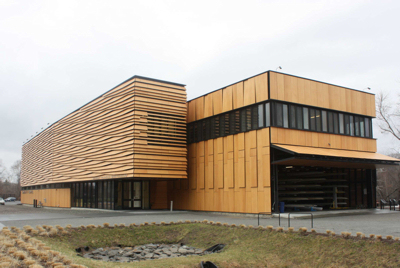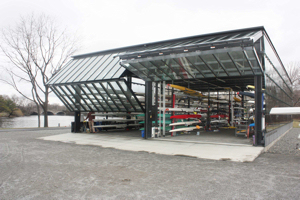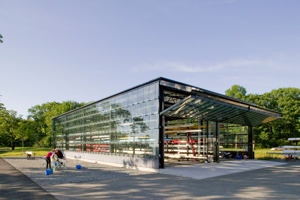Construction Of New Facilities Part Of Plan To Make Rowing More Accessible

|
The two-story, 29,000 sq. ft. Harry Parker building houses both the four-person and eight-person shells along with the administrative offices, meeting rooms, weight rooms, and locker rooms. The facility also has classrooms for the
G-ROW program, which introduces central city girls to the sport of rowing while providing educational opportunities through on-site tutoring. Click image to enlarge.
|  | |
The historic Charles River that winds through the Boston metro area is Mecca for the sport of crew. The Head of the Charles® Regatta held in October is among the world’s premier rowing events, running over two days and involving scores of
teams.
Rowing has long been regarded a traditional pastime for Ivy Leaguers and the elites. Today a new boathouse complex is opening up both the sport of crew and innovative architectural ideas along this stately river with the help of Wilson® Premier
Bi-Fold aluminum frame.
“If there is one phrase to describe our mission,” said Bruce Smith, Executive Director for Community Rowing Inc. (CRI), it’s “rowing for all.”
| |  |
| | | | The Parker building has a 40-foot wide by 18-foot tall door on both ends. Click images to enlarge. |
| |  |
For 20 years CRI has found ways to make rowing accessible to the public, growing steadily to sometimes representing over 40 percent of the rowing programs on the Charles River. When CRI speaks of inviting everybody to row, CRI means everybody. Smith
has even taken a mission to Iraq to start up the sport.
About five years ago CRI decided the size of their program demanded a permanent site and launched a fund raising campaign, eventually acquiring 3.5 acres on the Charles in the city of Brighton, where they built an $11 million boathouse complex. Two
very different looking buildings occupy the site.
The two-story, 29,000 sq ft Harry Parker building houses both the four-person and eight-person shells along with the administrative offices, meeting rooms, weight rooms, and locker rooms. The facility also has classrooms for the G-ROW program, which
introduces central city girls to the sport of rowing while providing educational opportunities through on-site tutoring.
In the glass and steel-framed 4,000 sq ft Ruth W. Somerville Sculling Pavilion, rowers access the two-person sculls in one half of the building. The other half is rented out to scull owners as a revenue stream for CRI.
The architects for the project, Nick Winton and Alex Anmahian of the firm Anmahian Winton Architects in Cambridge avoided mimicking the historic boathouses along the Charles for the Parker Boathouse and instead took their inspiration from the tobacco
barns that dot the Western Massachusetts landscape.
According to Anmahian, “The owners felt that the existing historic boathouses signified the traditional elitism of the sport and charged us with creating a contemporary design for their project that would set them apart and express their mission.”
Nevertheless, “CRI left it to us to develop an appropriate architectural language for their new boathouse,” recalls Anmahian.
 |
In the glass and steel-framed 4,000 sq. ft. Ruth W. Somerville Sculling Pavilion, rowers access the two-person sculls in one half of the building. The other half is rented out to scull owners as a revenue stream for CRI. The boathouse
uses two west-facing 20-foot wide by 18-foot tall bifold doors. Click images to enlarge. |  | |
 |
The first challenge was the site itself, which was compromised by its former use as a staging area for nearby roadwork. The area is unusually narrow for the kind of facility CRI and the architects envisioned. A typical boathouse stores 35 boats. CRI
required a structure to contain 170 boats.
To utilize the very narrow strip of land along the Charles River, Anmahian proposed that the Parker and Somerville buildings be built parallel to the river, with provisions for the amateur boaters. “The combination of a narrow site parallel
to the river and the wide turning radius required to maneuver the very long 60 ft boats to the docks necessitated extremely wide openings compared to those of traditional boathouses,” noted Anmahian. “To work properly, the doors had
to be wide, unobstructed by columns, and easy to operate.”
The answer came to Anmahian during the drive from his office to the CRI site. He noticed the Daniel Guggenheim Aeronautical Building at the Massachusetts Institute of Technology, where they needed a door that was almost 24 feet wide and more than
16 feet high to enable moving large assemblies into and out of the classroom building.
MIT had used a Wilson Premier Bi-Folding door to securely cover the large doorway and match the stylish design of the largely glass façade. “The doors seemed like an ideal fit for our requirements,” noted Anmahian.
Using the Premier door meant CRI architects could design a building that was wide open to the public at both ends and able to accommodate any of the rowers using it. “While experienced rowers can maneuver through relatively constrained areas,
we needed to eliminate barriers for novice rowers; the Wilson Door was a no-brainer.”
The doors fit in well with the building’s design concepts. The Parker building has a 40-foot wide by 18-foot tall door on both ends. The two 20-foot wide by 18-foot tall doors on the Somerville boathouse face west.
The doors on the Parker boathouse aren’t the only part of the building that opens up. Because it is important to dry off the large boats once they are brought back into the boathouse, the skin of the building is operable and made up of composite
panels of phenolic resin and wood veneer that is durable, natural, and sustainable.
The panels, which resemble the paddles at the end of an oar, operate as louvers and emulate the tobacco barns that inspired the design by opening up to allow air to circulate throughout the boat bays. As well as functioning as a drying system for
the boats inside, the openness enhances the impression CRI seeks to convey about their rowing programs, making their inventory of boats publicly visible.
The circulating air cools the interior of the building and the louver system enables the use of natural light inside the 10,000 sq ft storage area. This strategy limits the need for air conditioning to just a couple of weeks during the summer for
the offices on the second floor. This is one of the many sustainability features of the building, which include a green-ready roof, a geothermal heating and cooling system, and improved site permeability for managed storm runoff.
The Somerville boathouse has a totally different look. Made of glass attached to metal framing using clips made by EXTECH, the building is like a jewel box. Anmahian says, “Rather than concealing the boats, the glass skin celebrates the boats
by putting them on public display.”
As with the Parker boathouse, Anmahian Winton designed the Somerville building to breathe. The tempered glass is attached to the building as shingles, enabling the building to self ventilate for greater comfort for the rowers and to keep the boats
cool. The building doesn’t turn into an oven in summer; as the building heats up, air is induced to flow through its skin.
As with all high-end projects such as the CRI complex, the Premier door earns its place by carrying out the design idea and providing the functionality called for by the buildings’ users. First off, the doors are the biggest ventilators.
As for how the door fits in with building design, according to Anmahian, “it was important to the design of the project that the doors, particularly given their size, be clad in the same material and with the same pattern as the rest of the
building. The Wilson Doors provided a perfect framework for an aesthetic overlay.”
One of the attributes of the Wilson door is that its aluminum framing can support the exterior cladding the architect specifies for it, in this case wood on the Parker building and glass panels for the Somerville boathouse.
Despite its size, the Premier’s 6061-T aluminum aircraft frame is 40 percent lighter than steel yet it has the strength to minimize stress on the building structure and prevent buckling, even during the occasional high winds that blow down the
Charles. The door’s lightweight yet strong construction means minimal force is transmitted to the walls when the doors are operating or closed.
The vertical bi-folding design means the door requires little headroom or wall clearance. Moreover, there is no track on the floor in the way of the rowers and no need for support mechanisms or tracking from the ceiling to get in the way of rowers
as they take boats in and out of the building. The boat storage of the Parker building runs the entire length of the 200-foot-long structure and the doors enable easy access to the boats from either end.
The architects desired that the Parker’s overlap design on the exterior walls should be carried out on the doors. Wilson accommodated with armatures to operate the doors.
One of the benefits of the Premier drive system is that it can be located practically anywhere near the door. For the Parker building with its limited side room, Wilson mounted the drive on the door. The Somerville Premier doors’ drives are
on the side columns. This option enables the doors to fit into the limited wall area and provides easy access when service is needed.
Once constructed, the CRI building began to attract attention and several architectural awards, including the Harleston Parker Medal awarded annually to the “single most beautiful building or other structure” built in metro Boston over
the past ten years. CRI membership swelled from 1500 to 3000 rowers and many joined after seeing the building from the Mass Turnpike, making the largest rowing organization in the country even bigger.
As Anmahian puts it, “Good design is good business.”